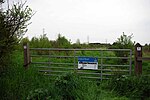Bata shoe factory
Accuracy disputes from March 2022Bata CorporationBuildings and structures completed in 1932Buildings and structures in EssexBuildings and structures in Thurrock ... and 4 more
Defunct retail companies of the United KingdomEngvarB from September 2013Grade II listed buildings in EssexShoe factories

The Bata shoe factory in East Tilbury is what remains of an industrial estate in Essex, England, which produced shoes for over 70 years. Founded in 1932 by Tomáš Baťa, the factory was "one of the most important planned landscapes in the East of England" in the 20th century. The factory closed in 2005.
Excerpt from the Wikipedia article Bata shoe factory (License: CC BY-SA 3.0, Authors, Images).Bata shoe factory
Princess Margaret Road, Thurrock
Geographical coordinates (GPS) Address Nearby Places Show on map
Geographical coordinates (GPS)
| Latitude | Longitude |
|---|---|
| N 51.479775 ° | E 0.41786944444444 ° |
Address
Princess Margaret Road
Princess Margaret Road
RM18 8PA Thurrock
England, United Kingdom
Open on Google Maps









